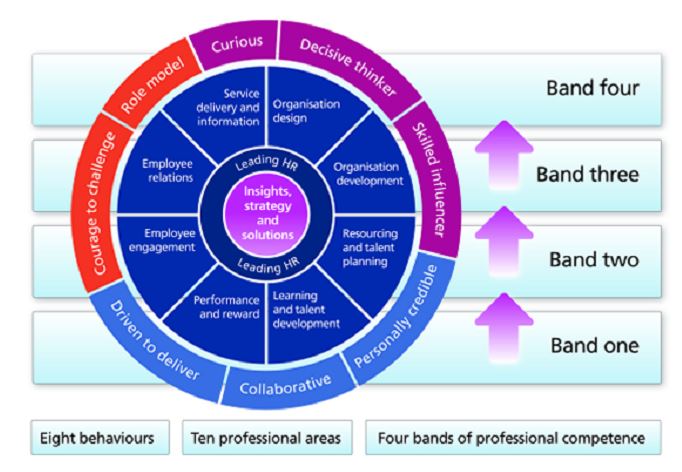
Purpose and Structure of the CIPD Profession Map
CIPD Profession Map plays a very important role in improving the performance of an organisation. It addresses specific HR issues from the top management levels to junior employees to ensure that there is enhanced performance of the workforce. This professional map covers ten professional areas and eight behaviours which are set in 4 bands as shown in the figure above. The structure of the CIPD Professional Map is designed to ensure that talents within an organisation are easily identified, developed and utilized to bring about much-needed success. Drivers of change and influencers of skills are clearly defined to help an organisation understand change patterns and how they should be modelled to bring about the desired outcome.
Summary of the Two Core Areas
At the core of CIPD Professional Map are insight strategies and solutions. The HR manager and all other top levels managers responsible for decision making are always responsible for developing insights as to how the current and future problems within the organisation should be addressed. As defined in this map, these decision-makers need to understand issues that are affecting an organisation, and measures that can be taken to address them. When developing solutions, care should be taken to ensure that there is a clear plan to address both short term and long term problems. According to this map, when developing short-term solutions, care should be taken to ensure that they do not jeopardize long-term solutions. The short term plans should be building blocks that would lead to achievements of long-term strategies. Similarly, it may be unrealistic to develop long-term solutions without considering how they may affect the short-term processes. A comprehensive and effective solution may ensure that the current problems are solved without jeopardizing the ability of the firm to achieve success in the future. Leading HR emphasizes the need for the leader to act as a role model. People always want to emulate their leaders. As such, leaders should ensure that they develop characters and good work ethics that are worth emulating by other junior leaders.
Summary of One Other Professional Area Relevant
Performance and rewards are other professionals are that is very important when it comes to improving the performance of the employees. According to the concepts brought out in this map, it is always important to recognise employees’ special capabilities, behaviour, skills, performance, and experience within an organisation. These should be rewarded accordingly to ensure that employees remain motivated in their work. Financial reward is one of the most commonly used forms of showing appreciation for the effort that employees have put in whatever they do. However, it is important to note that this is not the only form of reward that can be used to boost the morale of employees and improve their performance. For example, a firm may reward employees by giving them promotions if it is confirmed that they do deserve it. A reward can also be given by taking employees on a tour to break away from the monotonous work environment. Such tours also promote team spirit within an organisation.